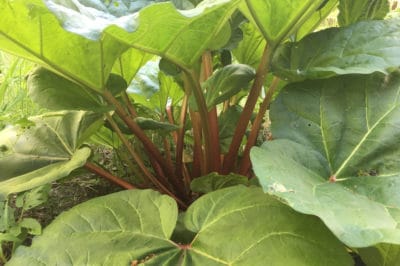Soil Nutrition
Rhubarb is a heavy feeding plant; it eats a lot and grows by leaps and bounds. Because of this, you’ll want to be sure to fertilize your plants. You can use:
- Compost
- Rotted Manure
- Organic products like blood meal, fish emulsion, etc.
- Mixtures of these
Spread the fertilizer around the base of your plants, and mix it into the soil, to be sure your plants will be well fed and productive.
Don’t use a chemical fertilizer on new plants; these often contain nitrates, which could kill your rhubarb!
Mulch Matters
To further feed your plants, and protect them, too, mulch with a layer of straw/manure mix. This will protect the roots and discourage weed growth, and while providing additional nutrients for your rhubarb to feed on.
Water, Water, Water
In warm, dry weather, your rhubarb will be thirsty. Keep your plants well watered for the best harvest. Check the soil often, watering whenever it seems dry. The straw mulch you provided earlier will help keep your plant moist, but watering will still be necessary.
Groom Your Plants Well
Keep an eye out for seed pods and flower stalks, and remove them from the plant as soon as you see them. These aren’t bad for your rhubarb, but they’ll reduce the size of your harvest by diverting nutrients from the edible stalks. Use a very sharp knife and get rid of these energy sappers as soon as they appear!
Add Nitrogen
Spring is an ideal time to give your rhubarb some nitrogen, which will make it very happy. After the first spring frost, when the earth is beginning to thaw, add some organic, high-nitrogen fertilizer to the ground. Doing this now instead of later will help prevent nitrogen damage to your plant’s roots, which could kill the plant.
General Maintenance
Once your rhubarb has been well-fed, thoroughly watered, and carefully trimmed, you’ll just want to keep an eye out for weeds; pulling weeds is the best way to protect your rhubarb plants from insects and disease.
Let It Grow
As you can see, rhubarb is a hardy plant that requires only a little investment of time and energy to reward you with a bountiful harvest. A little food and water, mixed with some attention and maintenance, will have your rhubarb thriving and growing all season long.
